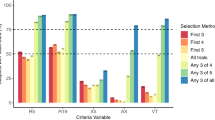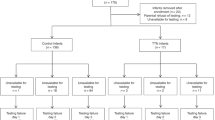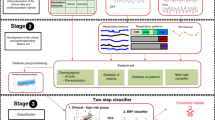Abstract
Objective:
To evaluate how a single infant car-seat challenge (ICSC) predicts subsequent respiratory physiology in premature infants.
Study Design:
Prospective observational study of infants born at <37 weeks gestational age. Subjects underwent three ICSCs and we evaluated clinical characteristics, pass rate, and predictive value of a single ICSC pass.
Result:
Completed three ICSCs on 60 subjects. Seven failed initial ICSC (11.7%). Those who failed had lower birth weights. Of the 53 that initially passed, 47 passed two subsequent tests (89%). Those who passed an initial test and failed a subsequent test had lower weights at each ICSC.
Conclusion:
Our results indicate that passing an ICSC is highly predictive of passing subsequent ICSCs. Lower weights at birth and at the time of ICSC were associated with increased risk of failure. We recommend including low birth weight as an inclusion criterion for ICSCs.
This is a preview of subscription content, access via your institution
Access options
Subscribe to this journal
Receive 12 print issues and online access
$259.00 per year
only $21.58 per issue
Buy this article
- Purchase on Springer Link
- Instant access to full article PDF
Prices may be subject to local taxes which are calculated during checkout

Similar content being viewed by others
References
Willett LD, Leuschen MP, Nelson LS, Nelson Jr. RM . Risk of hypoventilation in premature infants in car seats. J Pediatr 1986; 109 (2): 245–248.
Willett LD, Leuschen MP, Nelson LS, Nelson RM Jr. . Ventilatory changes in convalescent infants positioned in car seats. J Pediatr 1989; 115 (3): 451–455.
Bull MJ, Stroup KB . Premature infants in car seats. Pediatrics 1985; 75 (2): 336–339.
American Academy of Pediatrics Committee on Accident and Poison Prevention. Safe transportation of newborns discharged from the hospital. Pediatrics 1990; 86 (3): 486–487.
American Academy of Pediatrics Committee on Injury and Poison Prevention and Committee on Fetus and Newborn. Safe transportation of premature infants. Pediatrics 1991; 87 (1): 120–122.
Safe transportation of premature and low birth weight infants. American Academy of Pediatrics. Committee on Injury and Poison Prevention and Committee on Fetus and Newborn. Pediatrics 1996; 97 (5): 758–760.
Bull M, Agran P, Laraque D, Pollack SH, Smith GA, Spivak HR et al. American Academy of Pediatrics. Committee on Injury and Poison Prevention. Safe transportation of newborns at hospital discharge. Pediatrics 1999; 104 (4 Pt 1): 986–987.
Bull MJ, Engle WA . Safe transportation of preterm and low birth weight infants at hospital discharge. Pediatrics 2009; 123 (5): 1424–1429.
US Department of Labor BoLS 2011 Available from http://www.bls.gov/oes/current/oes291111.htm (cited 7 September 2012).
Williams LE, Martin JE . Car seat challenges: where are we in implementation of these programs? J Perinat Neonatal Nurs 2003; 17 (2): 158–163.
DeGrazia M . Stability of the infant car seat challenge and risk factors for oxygen desaturation events. J Obstet Gynecol Neonatal Nurs 2007; 36 (4): 300–307.
Fenton TR, Kim JH . A systematic review and meta-analysis to revise the Fenton growth chart for preterm infants. BMC Pediatr 2013; 13: 59–71.
Elder DE, Russell L, Sheppard D, Purdie GL, Campbell AJ . Car seat test for preterm infants: comparison with polysomnography. Arch Dis Child Fetal Neonatal Ed 2007; 92 (6): F468–F472.
Schutzman DL, Salvador A, Janeczko M, Weisberg L, Tran N, Porat R . A comparison of the infant car seat challenge and the polysomnogram at the time of hospital discharge. Arch Dis Child Fetal Neonatal Ed 2013; 98: F411–F415.
Jadcherla SR, Wang M, Vijayapal AS, Leuthner SR . Impact of prematurity and co-morbidities on feeding milestones in neonates: a retrospective study. J Perinatol 2010; 30 (3): 201–208.
Salhab WA, Khattak A, Tyson JE, Crandell S, Sumner J, Goodman B et al. Car seat or car bed for very low birth weight infants at discharge home. J Pediatr 2007; 150 (3): 224–228.
Thach BT, Stark AR . Spontaneous neck flexion and airway obstruction during apneic spells in preterm infants. J Pediatr 1979; 94 (2): 275–281.
Stark AR, Thach BT . Mechanisms of airway obstruction leading to apnea in newborn infants. J Pediatr 1976; 89 (6): 982–985.
Taylor B Guidelines for Evaluating and Expressing the Uncertainty of National Institute of Standards and Technology (NIST) Measurement Results. Commerce USDo, 1994.
Davis NL, Zenchenko Y, Lever A, Rhein L . Car seat safety for preterm noenates: implementation and testing parameters of the infant car seat challenge. Acad Pediatr 2013; 13 (3): 272–277.
Ramanathan R, Corwin MJ, Hunt CE, Lister G, Tinsley LR, Baird T et al. Cardiorespiratory events recorded on home monitors: comparison of healthy infants with those at increased risk for SIDS. JAMA 2001; 285 (17): 2199–2207.
Naulaers G, Daniels H, Allegaert K, Rayyan M, Debeer A, Devlieger H . Cardiorespiratory events recorded on home monitors: the effect of prematurity on later serious events. Acta Paediatr 2007; 96 (2): 195–198.
Acknowledgements
We thank the NICU nurses at Beth Israel Deaconess Medical Center in Boston, MA, for their assistance in the completion of this study, the Dorel Juvenile Group (Columbus, IN) for providing car-seat equipment for this study, the Harvard Neonatal-Perinatal Fellowship Program and the Scholars in Clinical Science Program for their support of Dr Davis. No external funding was secured for this study including from the Dorel Juvenile Group. We have no financial relationships relevant to this article to disclose. Dorel Juvenile Group had no input at any time in the design and conduct of the study; collection, management, analysis, and interpretation of the data; or preparation, review, or approval of the manuscript.
Author information
Authors and Affiliations
Corresponding author
Ethics declarations
Competing interests
The authors declare no conflict of interest.
Rights and permissions
About this article
Cite this article
Davis, N., Gregory, M. & Rhein, L. Test−retest reliability of the infant car-seat challenge. J Perinatol 34, 54–58 (2014). https://doi.org/10.1038/jp.2013.118
Received:
Revised:
Accepted:
Published:
Issue Date:
DOI: https://doi.org/10.1038/jp.2013.118
Keywords
This article is cited by
-
Screening for cardiopulmonary events in neonates: a review of the infant car seat challenge
Journal of Perinatology (2015)



